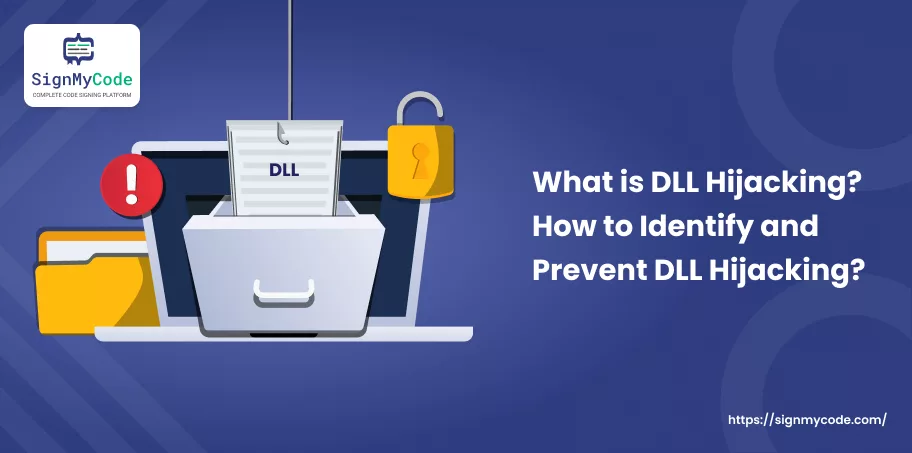What is DLL Hijacking? How to Identify and Prevent DLL Hijacking?

Ever happened – you clicked a random link by mistake but discovered your system working strangely? Maybe some programs crash, data goes missing, or pop-ups plague your screen.
It could be a malicious threat within your system, or simply, your system is the victim of a DLL Hijacking.
DLL Hijacking is a type of cyberattack that allows the attacker to steal your data or even take control of your system.
Sounds dangerous? YES, it is!
However, by implementing preventive measures, you can eliminate this digital threat from your system. Keep reading!
What Is DLL Hijacking?
DLL side-loading, or DLL (Dynamic Link Library) hijacking, is the process by which a malevolent actor replaces a trustworthy DLL file with a malicious one.
This may occur when a malicious DLL with the same name is installed at a location where the program is looking for DLLs, and the attacker knows this. The malicious code is executed when the DLL is loaded by the application, granting the attacker unapproved access and control over the machine.
What are DLL files?
DLL files are only found on Microsoft operating systems and contain the resources essential for an application to function properly.
According to Microsoft, the dynamic link library provides much of a Windows operating system’s functionality. DLL files are normally opened when an application starts.
These files allow programs to execute and optimize hard disc space. DLL files frequently run more than one program. Therefore, a single cyberattack, including a DLL hijack, might potentially interfere with and compromise several programs with only one compromised file.
How Does DLL Hijacking Work?
Here’s the typical process of how DLL Hijacking Works!
Application Search Order:
An application uses a predetermined search order to locate the necessary DLL when it has to load one. The directories listed in the system’s PATH environment variable, the application’s directory, and system directories are all covered by this search order.
Placement of Malicious DLLs:
When an attacker places a malicious DLL in the same location as a genuine DLL, the application will look for it first before locating the legitimate one. This might be a directory in the search order, or it could be the application’s directory.
DLL Loading:
The application uses the search order to find the DLL when attempting to load it. The application will inadvertently load and run the malicious code rather than the intended DLL if the malicious DLL is discovered first.
Execution of Malicious Code:
Once the malicious DLL is loaded, it can execute code with the same privileges as the application. This allows attackers to gain unauthorized access, steal sensitive information, or perform malicious activities on the compromised system.
How To Identify A DLL Hijacking Attacks?
Below is a simplified explanation of how to identify DLL hijacking attacks.
Unexpected Error Messages:
A DLL hijacking attack may be indicated if you receive error messages when opening a program mentioning faulty or missing DLL files.
Unusual Application Behaviour:
If an application starts behaving strangely, crashing frequently, freezing, or showing unexpected functionality, it could be a sign of an attack. Malicious DLL files are typically substituted for legitimate ones by DLL hijackers, which can cause an application to act strangely or stop functioning altogether.
Suspicious File Locations:
Check the locations of the DLL files that your applications are using. Legitimate DLL files are normally kept in system directories or the application installation path; however, manipulative DLL files can be located in other places.
File Timestamps:
Verify that DLL files have the same timestamps as their authentic equivalents. If the timestamps are off or suspicious, a manipulated DLL file may be indicated.
Security Software Alerts:
Pay attention to any alerts or notifications from your antivirus or security software. Some security solutions can detect and flag DLL hijacking attempts as potentially malicious activity.
Applications That Have Been A Victim Of DLL Hijacking Attacks (Real-Life Examples)
The following software applications have been identified as prone to DLL hijacking in Windows systems: iTunes, Adobe Reader (2010), VLC Media Player (2011), Skype (2012), The Microsoft Office Suite, which includes Word, Excel, and PowerPoint, and Internet Explorer (2014)
In 2010, iTunes for Windows had a DLL hijacking flaw that enabled any code to be executed. Similarly, Adobe Reader for Windows also allowed attackers to download and run malicious code.
In 2011, a DLL hijacking bug in Windows’ VLC Media Player was discovered, potentially enabling malicious code running by attackers.
In 2012, a Windows Skype DLL hijacking vulnerability was found. Attackers might have executed malicious code due to the vulnerability.
In addition, various versions of Microsoft Office Suite, including Word, Excel, and PowerPoint, have been targeted by DLL hijacking attacks, potentially enabling attackers to execute arbitrary code.
Furthermore, in 2014, Internet Explorer had a DLL hijacking vulnerability in certain versions, which could be exploited to execute malicious code.
Tools And Software That Can Help In Detecting DLL Hijacking
Below are some free tools that can help in detecting DLL Hijacking.
1. Process Monitor: On a Windows system, file system and registry activity can be observed using Process Monitor, a free application from Microsoft. It can assist in locating any unexpected file alterations or dubious DLL loading.
2. AppCheck Anti-Ransomware: One of the characteristics of this commercial security solution is the ability to identify DLL hijacking. It has the ability to watch over and defend against a variety of threats, including DLL hijacking attempts.
3. Sysinternals Suite: Many Windows programs from Microsoft that can help identify DLL hijacking are included in the Sysinternals Suite. It is possible to find suspicious DLLs and the related processes by using these two programs: Autoruns and Process Explorer.
How To Prevent DLL Hijacking?
Preventing DLL Hijacking requires a multi-layered approach. Here are some effective measures.
Keep Software up to Date:
Make sure you have the most recent security fixes by updating the plugins and content management system (CMS) on your blog on a regular basis.
Educate Users:
Instruct users to use caution when opening email attachments or downloading and installing software. Ask them to report any false or suspicious activity.
Be Careful with Downloads:
Only download software from trusted sources. Avoid downloading from unreliable websites or sources, as malicious DLLs might masquerade as legitimate files.
Make use of Trustworthy Security Software:
Set up and maintain an antivirus or anti-malware application on a regular basis. These instruments can be used to identify and stop DLL hijacking attempts.
Limit User Privileges:
To lessen the effect of a potential DLL hijacking attempt, utilize a non-administrator account for routine operations. Admin access should only be provided when absolutely required.
Configure Application Settings:
Some applications allow you to specify the exact path for DLL loading. If possible, configure applications to use absolute paths rather than relying on the default search order.
Eliminate Unneeded or Out-of-date Software:
Delete any out-of-date or unwanted software from your computer. The attack surface for possible DLL hijacking is smaller the fewer susceptible apps you have.
Conclusion
DLL hijacking is a potential problem for the corporate environment. However, you can significantly reduce your risk of becoming a victim of this sort of cyber threat by being aware of how DLL hijacking operates, spotting possible assaults, and taking preventive measures.
Remember that the key to preserving a secure working environment is to be proactive and keep your systems updated.


